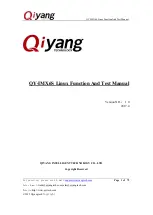
enCoRe™ V CY7C643xx, enCoRe™ V LV CY7C604xx TRM, Document No. 001-32519 Rev *H
53
General-Purpose I/O (GPIO)
6.1.1
General Description
The GPIO contains input buffers, output drivers, and config-
uration logic for connecting the enCoRe V device to the out-
side world.
I/O ports are arranged with (up to) 8 bits per port. Each full
port contains eight identical GPIO blocks. Each GPIO block
is used for the following types of I/O:
■
Digital I/O (digital input and output controlled by soft-
ware)
■
Analog I/O
Each I/O pin also has several drive modes, and interrupt
capabilities. All GPIO pins provide both digital I/O and ana-
log input capability.
Certain pins contain an option to bypass the normal data
path and output from an internal source. An example is I2C
outputs. These are described in
.
6.1.2
Digital I/O
One of the basic operations of the GPIO ports is to allow the
M8C to send information out of the enCoRe V device and
get information into the M8C from outside the device. This is
accomplished using the port data register (PRTxDR). Writes
from the M8C to the PRTxDR register store the data state,
one bit per GPIO. In the standard non-bypass mode, the pin
drivers drive the pin in response to this data bit, with a drive
strength determined by the Drive mode setting (see
). The actual voltage on the pin depends upon the
Drive mode and the external load.
The M8C reads the value of a port by reading the PRTxDR
register address. When the M8C reads the PRTxDR register
address, the current value of the pin voltage is translated
into a logic value and returned to the M8C. Note that the pin
voltage can represent a different logic value than the last
value written to the PRTxDR register. This is an important
distinction to remember in situations such as the use of a
read modify write to a PRTxDR register. Examples of read
modify write instructions include AND, OR, and XOR.
The following is an example of how a read modify write, to a
PRTxDR register, can have an unexpected and even inde-
terminate result in certain systems. Consider a scenario
where all bits of Port 1 on the enCoRe V device are in the
strong 0 resistive 1 Drive mode; so that in some cases, the
system the enCoRe V is in may pull down one of the bits by
an external driver.
mov
reg[PRT1DR], 0xFF
and
reg[PRT1DR], 0x7F
In the first line of this code, writing a FFh to the port causes
the enCoRe V to drive all pins high through a resistor. This
does not affect any bits that are strongly driven low by the
system the enCoRe V is in. However, in the second line of
code, it cannot guarantee that only bit 7 is the one set to a
strong 0 (zero). Because the AND instruction first reads the
port, any bits that are currently driven low externally are
read as a 0. These zeros are then written back to the port.
When this happens, the pin goes into a strong 0 state; there-
fore, if the external low drive condition ends in the system,
the enCoRe Vkeeps the pin value at a logic 0.
6.1.3
Analog and Digital Inputs
The High Impedance Analog mode turns off the Schmitt trig-
ger on the input path, which may reduce power consumption
and decrease internal switching noise when using a particu-
lar I/O as an analog input.
All modes, except High-impedance Analog, allow digital
inputs. The most useful digital input modes are Resistive
Pull Up (DM1, DM0 = 00b with Data = 1) or a fully high-
impedance input using open drain (DM1, DM0 = 11b with
Data = 1).
6.1.4
Port 1 Distinctions
Port 1 has two differences from the other GPIO ports. It has
stronger high drive (as does Port 0) and it has an option for
regulating all outputs to a 3 V/2.5 V/1.8 V level when in
strong drive mode. Refer to the device datasheet for the dif-
ferent current sourcing specifications of Port 1.
By setting the REG_EN bit in the IO_CFG1 register, Port 1
can be configured to drive strong high to a regulated 3 V/
2.5 V/1.8 V level. If REG_EN is set low, Port 1 pins drive to
Vdd in strong drive mode.
In Resistive High Drive mode ([DM1, DM0] = 00), the pins
pull up to the
Vdd level regardless of the regulator set-
ting for this port. Only Strong Drive mode allows for the out-
puts to be driven to the regulated level. When the REG_EN
bit is set high, pins configured for strong drive to regulated
level, while those in resistive pull-up mode drive to Vdd.
In their default state, all Port 1 I/O prevent DC current from
flowing into the pin when the pin voltage is above the chip
Vdd. This feature resolves the problem where the enCoRe
Vholds down the system I2C bus or provides a current leak-
age path from a powered peripheral during enCoRe V power
down or reset.
The open drain driver is capable of sinking 24 mA current
(required for sinking LEDs used for backlighting) and main-
taining a logic low state.
Regulated output level can be selected by bits 4 and 5 in the
IO_CFG1 register. For 3-V output level, the chip Vdd should
be greater than 3.1 V. For 2.5-V output, the chip Vdd should
be greater than 2.7 V, and for 1.8-V output level, chip Vdd
should be greater than 2.5 V.
6.1.5
Port 0 Distinctions
Port 0 has a stronger high drive. However, unlike Port 1, it
does not have an option to regulate the outputs when in














































